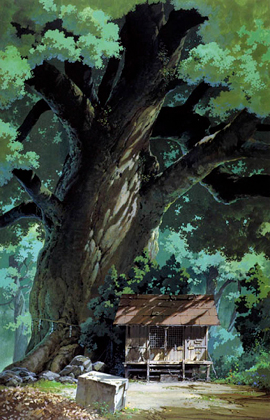
Tree Temple (still from Hayao Miyazaki’s
1988 animated film My Neighbor Totoro)
Jōshū (Ch. Zhàozhōu) lived from 778 to 897 C.E. and is often said to be the greatest Ch’an master of the Tang Dynasty. Over 10% of the cases in the classic koan collections Blue Cliff Record and Gateless Gate concern him, the most famous being:
A monk asked Jōshū, “Does a dog have buddha nature?”
Jōshū answered, “Mu” (literally, “nothingness”).
Jōshū studied with Nansen as a young monk and later traveled throughout China, visiting famous Ch’an masters in order to polish his understanding. At age 80 he settled down at Kuan-yin Temple in northern China, where he taught a small group of monks until his death 40 years later. The oak tree of the story would have been located at this temple—or, following a more ancient custom, the temple might have been located at the tree.
Bodhidharma was the Indian monk traditionally said to have brought the Dhyāna (or “Meditation”) School of Buddhism to China in the 6th century C.E. Among Buddhists of the Tang period, the question “Why did Bodhidharma come to China?” was the same as asking, “Why meditate?” or “What is the meaning of Ch’an?”
COMMENTARY:
Why did Bodhidharma come to China? Nowadays such questions are for dilettantes in robes. Better to say what you mean: What am I gonna get out of this? Why sit with a straight back for months or years on end?
Jōshū’s answer cuts to the chase: Did you think there was more to life than trees? Did you think there needed to be more? Who told you there needed to be more—and why did you believe them?
VERSE:
Give him an oak tree
And he’ll give you an oak tree.
Give a dog, a dog—
Jōshū made a good living
Giving people back the world.
Find all the Green Koans here.